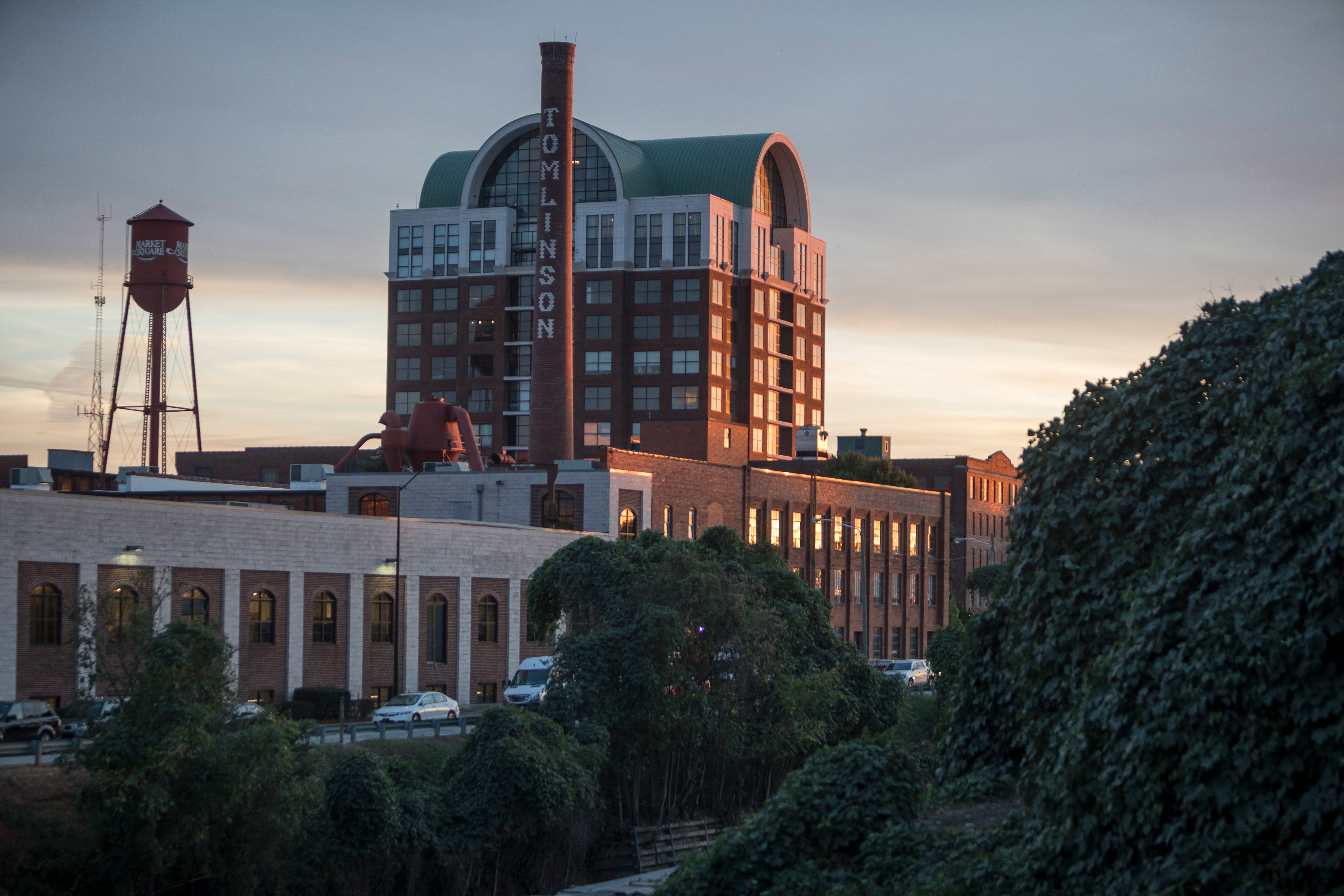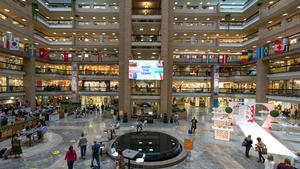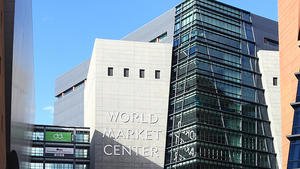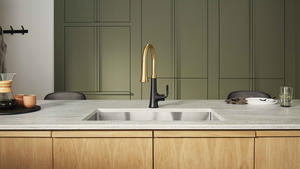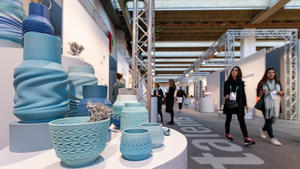It was a High Point Market unlike any other—from the sense of unease and the travel restrictions that kept many away to the supply chain challenges that have been plaguing the industry. Even the food was different. One designer told me that, without an abundance of hors d’oeuvres in showrooms, for the first time ever at Market, her team had to rearrange their appointments to carve out a moment for lunch.
Despite all the changes, for many exhibitors, Fall Market was ultimately a success: Perhaps most importantly, attendees reported that the COVID precautions implemented by the High Point Market Authority and individual showrooms made them feel safe. In addition, while the brands I spoke to clocked one-quarter to half of their typical Market traffic, those visitors who made it were there to shop. “We went into Market with a lot of appointments,” says Bethanne Matari, head of public relations for Currey & Company. “Most attendees had a buying plan and were serious about their approach, [which] worked out well for us.”
A successful Market was hardly a foregone conclusion. Given the unprecedented events that led up to it—including the cancelation of Spring Market and the extension of the fall event to span nine days instead of five—predictions were all over the map. When September’s Premarket event saw its largest-ever participation, some took the news as an optimistic sign that the industry was eager to shop—while others worried that those retailers would not return in October.
Both predictions came true. Theodore Alexander saw 40 percent of its showroom traffic but netted 55 percent of the orders it saw in previous Markets; at Hickory Chair, where the company had predicted attendance being down 75 percent, the staff celebrated being down 60 percent. “I think most companies would agree that while traffic was off pace, designers and retailers who did come to Market were actively working on projects and buying for their stores and showrooms,” says Laura Holland, Hickory Chair’s vice president of marketing.
“There’s no question that attendee traffic in InterHall was off from past Markets,” confirms Nathan Anthony co-founder and principal designer Tina Nicole, who has exhibited on the ground floor of IHFC for 10 years. “On a positive note, we found that was balanced with the seriousness of the interior designers and buyers who spent time in our showroom.”
At Sherrill Furniture Companies, sales reps spoke optimistically about opening new accounts. “That’s always a good sign that not only are returning buyers coming in, new prospects are also coming to see the collections,” says marketing manager Madeline Brown.
Because programming shifted to virtual formats, the pace for designer attendees shifted, as well. “Since seminars and networking events were not on the agenda, I enjoyed [spending that extra time] elsewhere,” says Durham, North Carolina–based designer Laura Koshel. “I enjoyed [lingering] in showrooms, having lengthy conversations with reps, and exploring products without the rush to get to the next seminar. It’s something to remember when planning my next Market trip: Take it easy!”
Exhibitors also wholeheartedly embraced virtual appointments, many for the first time, and were heartened by the results. I visited Market this way myself, attending upwards of 20 appointments from my New York apartment via FaceTime—a virtual drop-in that has become shockingly normalized in such a short amount of time. And while I had a colleague attending the show to guide my tours, many showrooms had reps whose Market was dedicated to leading Zoom tours for remote clients.
Though Market registration was reported to be 55 percent of pre-COVID levels, many who registered ultimately chose not to attend. But while official attendance counts from scanned badges are not yet available, the number of virtual attendees who corresponded directly with their vendors can’t ever be counted. However, for most brands, anecdotal evidence suggests that those virtual tours provided a noticeable boost—and offered early insights into what seems likely to become another tried-and-true way to experience Market.
“Based on the success we have seen from virtual and digital selling tools, we will continue to equip our sales force with the tools they need to find success, whether that means virtual tours, product videos, ample fabric swatches or wood cuttings—you name it,” says Brown of Sherrill’s focus moving forward. In addition to a website featuring hi-res images, pricing, dimensions and product descriptions for dealers, the company plans to debut videos of new product that help communicate comfort, style and scale.
Some companies also created video tours in their showrooms to translate the magic of the space for those who could not experience it in person—a move that likely has staying power, says Holland, who created a Hickory showroom video ahead of Market and collaborated on another with the Designer Discovery Collective during the show. “These videos are a new frontier for us,” she says. “We are looking at additional ways to bring the excitement and beauty of the showroom to customers and loyalists around the world.”
Thibaut also explored showroom videos this fall—one that deployed as Market kicked off, tapping some of the brand’s favorite tastemakers sharing their favorite finds, and another that will be distributed this fall. The company also shifted its social media strategy, sharing more than it normally would have over the course of the show. “We want it to be an experience coming into the showroom, so we typically launch a photo tour after Market—we don’t want to give it all away on social media,” says Stacy Senior Allan, Thibaut’s marketing director. “But this time, we did a little bit more so that everybody who wanted to participate and feel the energy got to see it."
High Point Market itself took a different approach to social media, tapping two or three designers each day to take over its Instagram account to showcase their favorite finds and call out trends, from tiered cocktail tables and brass accents to a medley of woven textures like rattan and cane. Many picked up on design elements that seemed to reflect the moment: “Soft lines in upholstery, as well as curved lines in case goods, resonated with me most this year,” says Koshel, who participated in the takeover. “Perhaps this year calls for some extra ‘hugging’—we also saw a lot of nubby textiles on sofas and chairs, perhaps a subconscious call for coziness.”
And while most noted a wash of neutrals, certain pops of color made regular appearances. “Welcoming spaces with touches of burgundy, aubergine, blues and golds are bountiful,” wrote John McClain in one of his takeover posts. “These hues are perfect for fall, but I predict [they] will be evergreen for a long time.”
Not everyone’s goal at the show is order writing, which can make measuring its success more difficult. “Since Nathan Anthony is a custom upholstery resource, we aren’t trying to sell container loads at the trade show,” says Nicole. But her experience this fall still felt like a win in its own right. “We exhibit at High Point Market to meet prospects, and the number of new leads we generated from being there definitely exceeded our expectations. The biggest surprise was how many first-to-High-Point-Market buyers we met—there were a lot of young interior designers, which added to the energy level.”
Another surprising development was the eagerness of some designers to place showroom models in upcoming projects—another sign that many who came to Market were shopping seriously for clients, and reflective of industry-wide manufacturing delays. “We don’t use Market as an order-writing show, but people bought off the floor because they were looking for inventory,” says Senior Allan. “They don’t have quick shipping from some of the factories, so we sold a lot more off the floor than we normally do.”
Ultimately, the Market served as a proof of concept for an uncertain future. “It showed us that even with the safety protocols in place and lack of ‘normal’ traffic, we can still have a very successful Market and productively engage with our retailers and designers,” says Theodore Alexander president Neill Robinson.
“The virtual tours were well-received, though the participating customers did say that nothing compares to being there in person,” adds Garth Robinson, vice president of sales at Theodore Alexander. “This Market showed that there are more ways to connect with your customers. Future Markets will be better attended, but we learned that the virtual component is here to stay in some form or fashion.”
Matari agrees. “There will always be a digital component in all we do [moving forward], including Markets,” she says. “That is the future.”
















